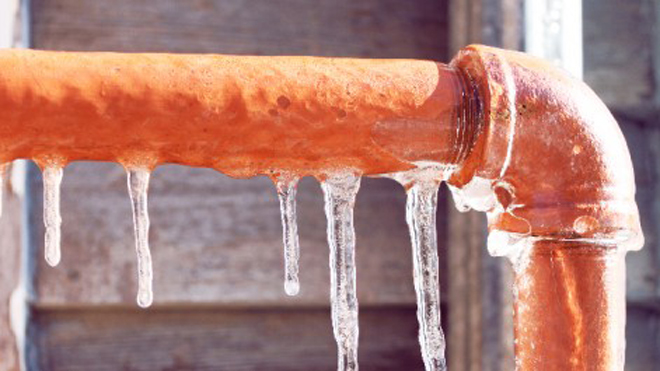Tips to Protect Your Plumbing from Freezing: Critical Strategies
Tips to Protect Your Plumbing from Freezing: Critical Strategies
Blog Article
They are making several great points on the subject of Winter Plumbing Precautions: Preventing Frozen Pipes in general in this great article just below.

Cold weather can damage your plumbing, particularly by freezing pipelines. Here's just how to avoid it from happening and what to do if it does.
Introduction
As temperatures decline, the danger of icy pipes rises, possibly causing pricey repair services and water damages. Comprehending how to prevent frozen pipes is critical for house owners in chilly environments.
Avoidance Tips
Protecting vulnerable pipes
Wrap pipelines in insulation sleeves or use heat tape to protect them from freezing temperature levels. Focus on pipelines in unheated or external locations of the home.
Heating methods
Maintain interior spaces appropriately warmed, particularly areas with pipes. Open cabinet doors to allow cozy air to distribute around pipelines under sinks.
Exactly how to recognize icy pipes
Look for decreased water circulation from faucets, unusual smells or noises from pipes, and visible frost on subjected pipelines.
Long-Term Solutions
Architectural modifications
Think about rerouting pipelines far from exterior wall surfaces or unheated locations. Include additional insulation to attics, basements, and crawl spaces.
Upgrading insulation
Invest in high-grade insulation for pipes, attic rooms, and wall surfaces. Appropriate insulation aids maintain consistent temperatures and decreases the threat of frozen pipelines.
Securing Outside Pipes
Garden tubes and outside faucets
Separate and drain garden hoses before winter season. Set up frost-proof faucets or cover outdoor faucets with shielded caps.
Understanding Icy Pipes
What creates pipes to ice up?
Pipelines ice up when subjected to temperature levels below 32 ° F (0 ° C) for extended periods. As water inside the pipes ices up, it broadens, putting pressure on the pipeline walls and possibly causing them to break.
Threats and damages
Icy pipelines can lead to water supply disruptions, building damages, and costly repairs. Ruptured pipelines can flood homes and cause considerable architectural damage.
Indications of Frozen Piping
Identifying icy pipes early can prevent them from breaking.
What to Do If Your Pipelines Freeze
Immediate actions to take
If you presume icy pipelines, maintain faucets available to relieve stress as the ice melts. Use a hairdryer or towels taken in hot water to thaw pipelines gradually.
Conclusion
Protecting against frozen pipes needs aggressive steps and quick feedbacks. By recognizing the reasons, signs, and preventive measures, homeowners can safeguard their plumbing during winter.
6 Proven Ways to Prevent Frozen Pipes and Protect Your Home
Disconnect and Drain Garden Hoses
Before winter arrives, start by disconnecting your garden hoses and draining any remaining water. Close the shut-off valves that supply outdoor hose bibs and leave the outdoor faucet open to allow any residual water to drain. For extra protection, consider using faucet covers throughout the colder months. It’s also important to drain water from any sprinkler supply lines following the manufacturer’s directions.
Insulate Exposed Pipes
Insulating your pipes is an effective way to prevent freezing. Pipe insulation is readily available at home improvement stores and is relatively inexpensive. Pay close attention to pipes in unheated areas such as the attic, basement, crawl spaces, or garage. Apply foam insulation generously to create a buffer against the cold. You can also wrap your pipes in heat tape or thermostat-controlled heat cables for added warmth.
Seal Air Leaks
Inspect your home for any cracks or openings that could let in cold air. Seal any holes around the piping in interior or exterior walls, as well as the sill plates where your home rests on its foundation. Additionally, make sure to keep your garage door closed unless you’re entering or exiting. Leaving it open creates a significant air leak that can lead to frozen pipes.
Allow Warm Air Circulation
During cold snaps, it’s essential to allow warm air to circulate evenly throughout your home. Leave interior doors ajar to promote better airflow. Open kitchen and bathroom cabinets to help distribute heat consistently around the rooms. If you have small children or pets, be sure to remove any household chemicals or potentially harmful cleaners from open cabinets for safety.
Let Faucets Drip
A small trickle of water can make a big difference in preventing ice formation inside your pipes. When temperatures drop significantly, start a drip of water from all faucets served by exposed pipes. This continuous flow helps prevent the water from freezing. Additionally, running a few faucets slightly can relieve pressure inside the pipes, reducing the chances of a rupture if the water inside does freeze.
https://choateshvac.com/6-proven-ways-to-prevent-frozen-pipes-and-protect-your-home/

As a keen reader on Winter Plumbing Precautions: Preventing Frozen Pipes, I assumed sharing that excerpt was beneficial. Appreciated our entry? Please share it. Let others locate it. Thank you for your time invested reading it.
Booking Page Report this page